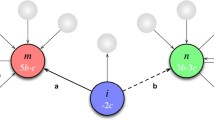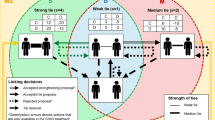Abstract
Spontaneous emergence of institutionalized cooperation in ubiquitous social dilemmas still is a field of highest relevance in behavioral and organizational economic research. In contrast to the theoretical prediction of defective behavior, manifold forms and degrees of cooperation exist in reality. We explain the emergence of general cooperation, even in one-shot interactions with strangers, from local interactions in a network through what we call a social-leverage mechanism. By this, more agents than just the two interaction partners get involved in an interaction, particularly common acquaintances. We analyze the social-leverage mechanism and conditions of cooperation under locality, common acquaintanceship, related assortativity, as well as “weak” and “strong ties” in the social network. We trace the co-evolution of the network, its structural dynamics, and stable cooperative equilibria. Our model relates to the tradition of emergent coordination in decentralized, non-Walrasian search, coordination and exchange systems (e.g., Diamond 1984; Axtell 2005) and in purely local interactions on, e.g., ring networks (e.g., Albin and Foley J Econ Behav Organ 18(1), 27–51, 1992). We conclude that, under social leverage, just local interaction may generate and stabilize general cooperation. We consider this the emergence of an exchange and trade system (a market) and relate this to empirical cases of the emergence of exchange cultures in the early Silk Road (seventh–ninth century) and in contemporary African countries, when formal enforcement through states and courts are largely lacking. We conclude applications and policy implications for cutting-edge techno-organizational areas of AI and platform economies.




Similar content being viewed by others
Notes
We owe this to one of the reviewers and elaborated it in a particular section below.
References
Albin P, Foley DK (1992) Decentralized, dispersed exchange without an auctioneer: a simulation study. J Econ Behav Organ 18(1):27–51
Alger I (2010) Public goods games, altruism, and evolution. J Public Economic Theory. Journal of Public Economic Theory is JPET 12(4):789–813
Alger I, Weibull JW (2010) Kinship, incentive, and evolution. Am Econ Rev 100(4):1725–1758
Aoki M (1988) Information, incentives, and bargaining in the Japanese economy. Cambridge University Press, New York
Axelrod R (1984/2006) The evolution of cooperation. Basic Books, New York
Axtell R (2005) The complexity of exchange. Econ J 115:F193–F210
Barabási AL, Albert R (1999) Emergence of scaling in random networks. Science 286(5439):509–512
Bauer PT (1954) West African trade: a study of competition, oligopoly and monopoly in a changing economy. Cambridge University Press, Cambridge
Bergstrom TC (2003) The algebra of assortative encounters and the evolution of cooperation. International Game Theory Review 5(3):211–228
Bergstrom TC (2013) Measures of assortativity. Biol Theory 8(2):133–141
Bergstrom T, Stark O (1993) How altruism can prevail in an evolutionary environment. Am Econ Rev Papers and Proceedings 83:149–155
Bilancini E, Boncinelli L (2009) The co-evolution of cooperation and defection under local interaction and endogenous network formation. J Econ Behav Organ 70(1–2):186–195
Bilancini E, Boncinelli L, Wu J (2018) The interplay of cultural intolerance and action-assortativity for the emergence of cooperation and Homophily. Eur Econ Rev 102:1–18
Boyer T, Jonard N (2014) Imitation and efficient contagion. J Econ Behav Organ 100(2343):20–32
Bramel D (1969) Interpersonal attraction, hostility, and perception. In: Mills J (ed) Experimental social psychology. Macmillan, New York
Brown R (1965) Social psychology. Free Press, New York
Commons JR (1990) [1934]. Institutional economics. Its place in political economy. 2 Vols. New York: Macmillan. Repr.: New Brunswick: Transaction Publishers
Cui Z, Wang R (2016) Collaboration in networks with randomly chosen agents. J Econ Behav Organ 129:129–141
Diamond, P. A.1984. A search-equilibrium Approach to the Micro Foundations of Macroeconomics. Cambridge, MA: MIT Press
Elsner W (2010) The process and a simple logic of “Meso”. On the co-evolution of institutional emergence and group size. J Evol Econ 20(3):445–447
Elsner W, Schwardt H (2014) Trust and arena size: expectations, institutions, and general trust, and critical population and group sizes. J Inst Econ 10(1):107–134
Eshel I, Samuelson L, Shaked A (1998) Altruists, egoists, and hooligans in a local interaction model. Am Econ Rev 88:157–179
Fafchamps M (1996) The enforcement of commercial contracts in Ghana. World Dev 24(3):427–448
Fafchamps M, Minten B (2001) Property rights in a flea market economy. Econ Dev Cult Chang 49(2):229–268
Fafchamps M, Conning J, Srivastava P (1993) Enterprise finance in Kenya. RPED. The World Bank, Washington, DC
Ghosh P, Ray D (1996) Cooperation in community interaction without information flows. Rev Econ Stud 63:491–519
Graebner C, Elsner W, Lascaux A (2018) To trust or to control: informal value transfer systems and computational analysis in institutional economics. J Econ Issues 52(2):559–569
Granovetter MS (1973) The strength of weak ties. Am J Sociol 78(6):1360–1380
Greif A (1993) Contract enforceability and economic institutions in early trade: the Maghribi traders’ coalition. Am Econ Rev 83(3):525–548
Hopkins AG (1973) An economic history of West Africa. Longman, London
Jackson MO, Wolinsky A (1996) A strategic model of social and economic networks. J Econ Theory 71:44–74
Jun T, Sethi R (2007) Neighborhood structure and the evolution of cooperation. J Evol Econ 17:623–646
Kandori M (1992) Social norms and community enforcement. Rev Econ Stud 59:63–80
Kendall G, Yao X, Chong SY (2007) The iterated Prisoner’s dilemma: 20 years on. World Scientific, Singapore
Lindgren K (1997) Evolutionary dynamics in game-theoretic models. In: Arthur WB, Durlauf S, Lane D (eds) The economy as an evolving complex system II. Addison-Wesley, Reading, pp 337–367
Mailath GJ, Samuelson L (2006) Repeated games and reputations: long-run relationships. Oxford University Press, Boston
Masuda N (2003) Spatial Prisoner’s dilemma optimally played in small-world networks. Phys Lett A 313(1–2):55–61
McCannon BC, Asaad CT, Wilson M (2018) Contracts and trust: complements or substitutes? J Inst Econ 14(5):811–832
Milgrom PR, North DC, Weingast B (1991) The role of institutions in the revival of trade: the law merchant, private judges, and the champagne fairs. Econ Polit 2:19), 1–19),23
Munshi K (2011) Strength in numbers: networks as a solution to occupational traps. Rev Econ Stud 78(3):1069–1101
North DC (1990) Institutions, institutional change, and economic performance. Cambridge University Press, Cambridge
Pacheco JM, Traulsen A, Nowak MA (2006) Active linking in evolutionary games. J Theor Biol 243:437–443
Rubinstein A (1979) Equilibrium in Supergames with the overtaking criterion. J Econ Theory 21:1–9
Shapiro C, Stiglitz JE (1984) Equilibrium unemployment as a worker discipline device. Am Econ Rev 74(3):433–444
Wang J, Suri S, Watts DJ (2012) Cooperation and Assortativity with dynamic partner updating. Proc Natl Acad Sci 109(36):14363–14368
Weibull JW (1995) Evolutionary game theory. MIT Press, Cambridge
Young HP (1998) Individual strategy and social structure. Princeton University Press, Princeton
Zhang YL, Elsner W (2017) A social-leverage mechanism on the silk road: the private emergence of institutions in Central Asia, from the 7th to the 9th century. J Inst Econ 13(2):379–400
Author information
Authors and Affiliations
Corresponding author
Additional information
Publisher’s note
Springer Nature remains neutral with regard to jurisdictional claims in published maps and institutional affiliations.
Appendix Proof of Lemma 4.1
Appendix Proof of Lemma 4.1
If player i chooses defection, his expected payoffs are
If player i chooses cooperation, his expected payoffs are
Thus, cooperation is sustained, if
Similarly for agents j, k:
Cooperation is an equilibrium in the group if
Rights and permissions
About this article
Cite this article
Zhang, Y., Elsner, W. Social leverage, a core mechanism of cooperation. Locality, assortment, and network evolution. J Evol Econ 30, 867–889 (2020). https://doi.org/10.1007/s00191-019-00642-x
Published:
Issue Date:
DOI: https://doi.org/10.1007/s00191-019-00642-x
Keywords
- Cooperation
- Evolution
- Games
- Local interaction
- Network formation
- Assortativity
- Social-leverage contracting
- Spontaneous markets




